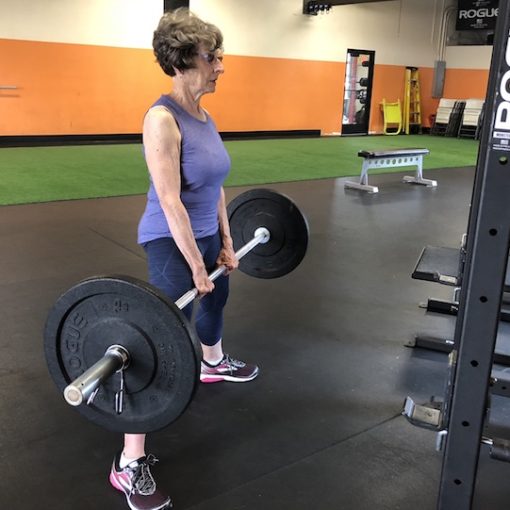I have created a couple of programs for some of our Mad Dawg athletes training at home or a commercial gym like 24 Hour Fitness. If you are a Mad Dawg athlete and want to talk about how to use one of these or need to tweek it for your own special needs, email or text me.
6 week barbell program: This program is a cleaned up version of the programs we used to use at Mad Dawg. I’ve gone through and simplified it a little but most athletes will recognize it. I was trying to fit 6 weeks on one page so you do the same program on week one and week four, as well as, week 2 and week 5. One change to the exercises is that I have added breathing to push-ups and rocking. Two breaths means it takes two breaths on the way down and two breaths on the way up of a push-up. You can make it harder by adding two breaths each at the top and bottom. That’s some time under tension! Many times if the shoulders aren’t stable, the athlete will hold his/her breath to add stability so we are taking that compensation away. If you aren’t sure if that is your compensation, back off on the leverage by either elevating the push-up or going to your knees and see of it feels more stable. Remember all push-ups should be in a slightly hollow position.
6 week kettlebell program: This program is for athletes with just kettlebells at home or for those who want to keep it simple in the gym. You can use one KB with this program but the best option is to have three pairs, e.g. 8, 12, 16 or 12, 16, 20 (see below for where to buy KBs). A couple of exercise notes: For the Turkish Get-Up (TGU) or Get-Up, partial means either just the rollover, to your elbow or to your hand (there’s a good explanation of the TGU – partial progression near the end of my warm-up video). Regarding the underswitch to scorpion, (underswitch explained and scorpion explained, this demo includes the crab reach, you can add that on if you feel like it, but it’s not necessary), the crab position, the underswitch starting position, can be a great shoulder opener/stabilizing drill, especially when it is combined with the Get-Up. However, for many athletes, shoulder extension, hands/wrists behind the hips, can be problematic. Here are three tips: Start with the scorpion and only include the switchunder when you are super comfortable with the scorpion. Secondly, keep you spine as neutral as you can in the crab and start by just holding the crab position statically for 3 – 5 breaths. Finally, keep your shoulders away from your ears and push the floor away from you when you are moving.
John Muir Trail 4 week intro: Susan and I are planing to hike some/most of the John Muir Trail next year and we are starting our training now. This is the beginning 4 week cycle (we’ll probably do each 4 week cycle twice as to keep it simple). If you want to follow along, let me know. Here are a few things that are notably different from traditional Mad Dawg programming (really, most traditional class programming):
- This program is very strength-y. This program assumes you have a sport or activity that you really love and brings you joy and you will do that activity for your conditioning. For more on this assumption please read Train Like a Professional Athlete.
- Minimal time commitment. Each workout should be about 40 minutes (or less) including warm-up. Because the rest periods are long, you can even start the workout with light weight and do the warm-up in the rest between sets.
- Minimal equipment investment. My recommendation is three pairs of KBs (8, 12, 16 KG or 12, 16, 20 kg or 16, 24, 32 KG) and a light sandbag. I don’t care how strong you are, 30 lbs (the weight limit for the small sand bag) is more than enough. You can get the larger size but only load it to 30 – 40 lbs. You’ll see why in later months. Optional equipment is barbell and plates for deadlifting, a larger sand bag, a pull-up bar and a tire to drag, but these aren’t necessary.
- Minimal variation. For exercises, we’ll use one each of a hinge, a squat, a push/pull, a loaded and unloaded locomotion and a static and a dynamic core-focused for each 4 week cycle. There is no load specified because you will know what KB you squat and swing. The rest are movement progressions. The way we will progress is increasing reps or decreasing rest times. Obviously, over time you will increase weight or the swing or squat; however, this will probably only happen once or twice in a year. If you can two-hand swing the 32 KG (men)/ 24 KG (women), snatch a 24 KG (men)/16 KG (women) and double KB front squat 32 KG (men)/ 24 KG (women) in a workout, I can pretty much guarantee you are strong enough for your sport. Here is a good summary of the thought process behind the programming (just listen to the dynamic effort portion, the first 20 minutes. Sorry for the cursing.) Also Simple and Sinister by Pavel and Easy Strength by Dan John and Pavel are also good resources.
Warm-Ups
Some of these workouts contain a warm-up. I have also uploaded some warm-ups you can do for hinging (here and here), squatting (here and here), push/pull (here and here). You can do these 1 – 3 times for your warm-up. These warm-ups assume that you have a “test,” a movement or exercise, that indicates if you are making progress. For instance, my movement is either the bird dog or a simple toe touch. If you need help with finding a “test,” email or text me.
Purchasing Kettlebells
There are four places I would recommend buying kettlebells:
- Kettlebell USA – I have not purchased from here but these are a good place to buy both regular or competition KBs. I am using competition KBs more, especially for lighter weights because they fit on my arms better when racking and in windmills and get-ups. They also have a small price reduction when you buy a set.
- Rogue – This is where we bought the majority of the KBs at Mad Dawg.
- Play It Again Sports in Dublin, CA – They usually have the Apollo KBs which are cheaper but not as nice as the Rogue or Kettlebell USA.
- Marshalls, TJ Maxx, Ross, etc. – If you using lighter KBs, e.g. 4 or 8 KG, for your windmills and get-ups, I would buy 10 or 15 lb Marika KBs. They fit similar to the competition KBs and they are way cheaper.





